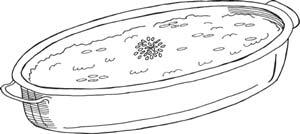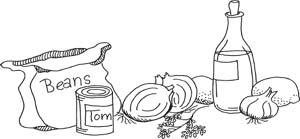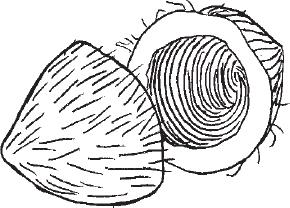Nourishing Traditions: The Cookbook That Challenges Politically Correct Nutrition and The... (138 page)
Authors: Sally Fallon,Pat Connolly,Phd. Mary G. Enig
Tags: #Non-Fiction, #Reference, #Science, #Health
This French version of baked beans and various meats makes a wonderful party dish. It is traditionally made with preserved duck legs but you may also use fresh duck pieces.
Cover beans with warm water and leave in a warm place for 24 hours. In a flameproof casserole that is wide and shallow rather than deep, saute the preserved or fresh duck pieces in their own fat until nicely browned on all sides. Remove and reserve. Saute onion in duck fat. Add wine and boil down. Drain beans, rinse and add to the pot along with stock. Bring to a boil and skim. Stir in lemon juice, salt and pepper, garlic and thyme and bay leaf. Return the duck pieces to the casserole, cover and bake at 350 degrees for about 3 hours, stirring occasionally.
Meanwhile, brown lamb pieces in olive oil in a heavy pan. Place canned tomatoes in food processor, pulse a couple of times and add to lamb. Add garlic and season with salt and pepper. Cover and simmer for about 3 hours or until lamb is tender. About ½ hour before casserole is finished, add sliced sausage to beans.
When beans are tender, remove thyme and bay leaf and stir in the cooked lamb. Saute bread crumbs in butter until browned. Mix with parsley and optional cheese and strew over casserole. Bake another 20 minutes, uncovered, at 350 degrees or until bread crumbs are crusty.
One objection frequently made to a diet based primarily on grains and pulses is that these foods contain phytic acid. Particularly abundant in the germ of grains and in the skins of pulses, it combines in the intestinal tract with calcium, iron, magnesium and zinc to form insoluble phytates that are then eliminated. According to some researchers, the elimination of these minerals in the form of insoluble phytates can lead to severe deficiencies in those who nourish themselves predominantly with grains, unless the whole grains have been soaked or fermented before they are consumed. The role of phytic acid has been most thoroughly studied in bread. In sourdough bread, with a long fermentation that is partially a lacto-fermentation, the phytic acid is almost completely destroyed. On the other hand, bread made with brewers yeast undergoes a rapid fermentation that is in large measure an alcoholic fermentation; and its phytic acid content remains largely intact. The phytase (enzyme needed to break down phytic acid) present in grains cannot do its work unless the pH becomes sufficiently low and the period of fermentation lasts a sufficiently long time. Claude Aubert
Les Aliments Fermentes Traditionnels

BAKED BEANS, FRENCH STYLE
Serves 6-8
4 cups small white beans
filtered water
1 cup extra virgin olive oil
1 small can tomato paste
4 cloves garlic, peeled and mashed
several sprigs fresh thyme, tied together
2 medium red onions, finely chopped
juice of 2 lemons
sea salt and pepper
This unusual and delicious recipe calls for cooking the beans in oil rather than in liquid. A long soaking is therefore essential or the beans will be too hard.
Bring a pot of water to the boil and pour over beans. Leave in a warm place for 12 hours. Pour beans into a colander, drain and rinse. Repeat the soaking process, leaving beans in a warm place another 12 hours. Pour beans into a colander, drain and rinse.
Heat olive oil in a pot and add beans, tomato paste, salt, thyme and garlic. Blend well. Bake at 300 degrees for about 6 hours, stirring occasionally to prevent burning. If beans seem too dry, add more olive oil. Beans are done when they are soft but they will not be mushy like beans cooked in liquid. Remove thyme, fold in onions and lemon juice, season to taste and serve.
Primitive cultures showing a high immunity to dental disease and freedom from other degenerative processes had diets containing at least 10 times the vitamins A and D and at least 4 times the other vitamins and minerals found in a good modern diet. When the only foods available are unrefined and unprocessed, man must eat a wide variety and a large amount to meet his body's energy requirements. This usually supplies his body with the proper nutrients for good health and growth. Refining and processing of foods removes or destroys essential elements. It can make food a concentrated source of energy with little nutritional value. Modern man can easily fill his body's energy requirements without obtaining the nutrients for good health. When primitive man adopts the foods of modern society, his carbohydrate intake remains the same, but the form changes from whole grains and beans to sugar and other refined products. When primitive man adopts the foods of modern society, tooth decay and degenerative diseases follow. "Nutrition: The Appetite of Man"
PPNF

MARCH LUNCH
Natural Yeast Herb and Nut Bread
with Butter
BEANS AND RICE, JAMAICAN STYLE
Serves 6-8
1 cup red kidney beans
warm filtered water
1 can coconut milk or 7 ounces creamed coconut (see
About Coconut Products
)1 bunch green onions, chopped
3 jalapeno peppers, seeded and chopped
3 cloves garlic, mashed
2 teaspoons dried thyme
2 teaspoons sea salt
1 teaspoon dried green peppercorns, crushed
1 cup brown rice, soaked at least 7 hours
Cover beans with warm water and leave overnight in a warm place. In the morning, drain and rinse the beans and place in a pot. Add enough water to cover the beans, bring to a boil and skim. Add remaining ingredients except rice. (If using creamed coconut, stir until it is melted.) Cover and simmer for about 6-8 hours or until beans are tender. Drain the rice and add to the pot with enough filtered water to cover the rice and beans about ½ inch. Bring to a boil and cook, uncovered, until liquid has reduced to level of rice and beans. Cover and cook on lowest heat for about 30 minutes.
In the summer of 1965, I met a wise man from the East, a Japanese philosopher who had just returned from several weeks in Saigon. "If you really expect to conquer the North Vietnamese," he told me, "you must drop Army PX's on them—sugar, candy and Coca-Cola. That will destroy them faster than bombs." William Dufty
Sugar Blues
Sir Robert McCarrison, M.D. of England, carried on elaborate experiments at Coonor, India, using over 2,000 clinical animals under controlled conditions.
Selecting out two of his experiments: The rats in one group were fed on the diet of the Hunzas of northern India. The Hunzas are large, strong and healthy, do physical work in their 80's and 90's and many live over 100 years. The diet of the Hunzas consists chiefly of whole grains, raw fruits and vegetables grown on organically fertilized soil and milk products from goats. The groups of rats fed on the Hunza diet grew large, were healthy, long-lived, docile and affectionate.
The rats of the second group were fed on the diet of the Madrasi of southern India. The Madrasi are small, puny ailing people with a life span of less than 20 years.
The Madrasi live on such foods as polished rice, tapioca, pulses, condiments, very little milk and few vegetables (mostly refined foods). The rats fed on this Madrasi diet were sickly, nervous, vicious and short-lived and had the diseases common to the Madrasi. R. Dean Conrad
The Great American Tragedy

BLACK-EYED BEANS, PERSIAN STYLE
Serves 6
6 cups basic black-eyed beans (
Basic Beans
)4-5 bunches chard, washed and chopped
2 bunches green onions, finely chopped
1 bunch parsley, finely chopped
1 bunch cilantro, finely chopped
1 medium onion, chopped
2 tablespoons butter
2 tablespoons extra virgin olive oil
4-5 dried limes (available at Middle Eastern markets) or grated rind and juice of 3 fresh limes
Saute green onions, parsley and cilantro in butter and olive oil, stirring constantly. Remove to a casserole. Saute onion and add to parsley mixture. If you are using dried limes, open up and remove seeds and membranes. Add dried limes (including skins) or lime juice and rind, cooked beans (with their juices) and chopped chard to casserole. Cover and simmer about 20 minutes. Serve with
basic brown rice
.
If you are having thyroid problems, check the amount of soy in your diet; or if you eat a lot of soy foods, watch your thyroid function. . .. This is the third strike against soy as the "health food" it has become, thanks to incessant propaganda by the huge agribusiness giants behind the world's biggest money crop.
Vegetarians have long championed soy foods as the "ideal" source of protein despite the scientific facts that disprove the notion. Textured soy protein, which is more widely used in packaged and refined foods and meat products (hamburger extender) than most of us ever imagined, now has three antinutrients that should make anyone think twice before making it a major part of the diet. The three antinutrients are: (1) a large amount of phytic acid, which binds up and prevents absorption of minerals, especially zinc, calcium and magnesium needed by the body; (2) trypsin inhibitors, which cannot be refined out of the soy mash (trypsin is an important enzyme in digestion); (3) isoflavones, genistein and daidzein, three phytochemicals that have now been shown to have antithyroid activity. . .[Researchers found] that soy isoflavones, which are now being especially hyped for possible anticancer activity, are the most potent of the thyroid inhibitors followed by daidzein and then genistein. In a previous study, the team of plant chemical researchers had found similar antithyroid activity in some known bioflavonoids, including. . .quercetin. Most of the bioflavonoids, however, have not been found to inhibit thyroid function to any detrimental degree. . .. No other dietary staple has so many antinutrient drawbacks as soy. Conversely, no other food has so many public relations firms and lobbyists working for it. Tom Valentine
True Health